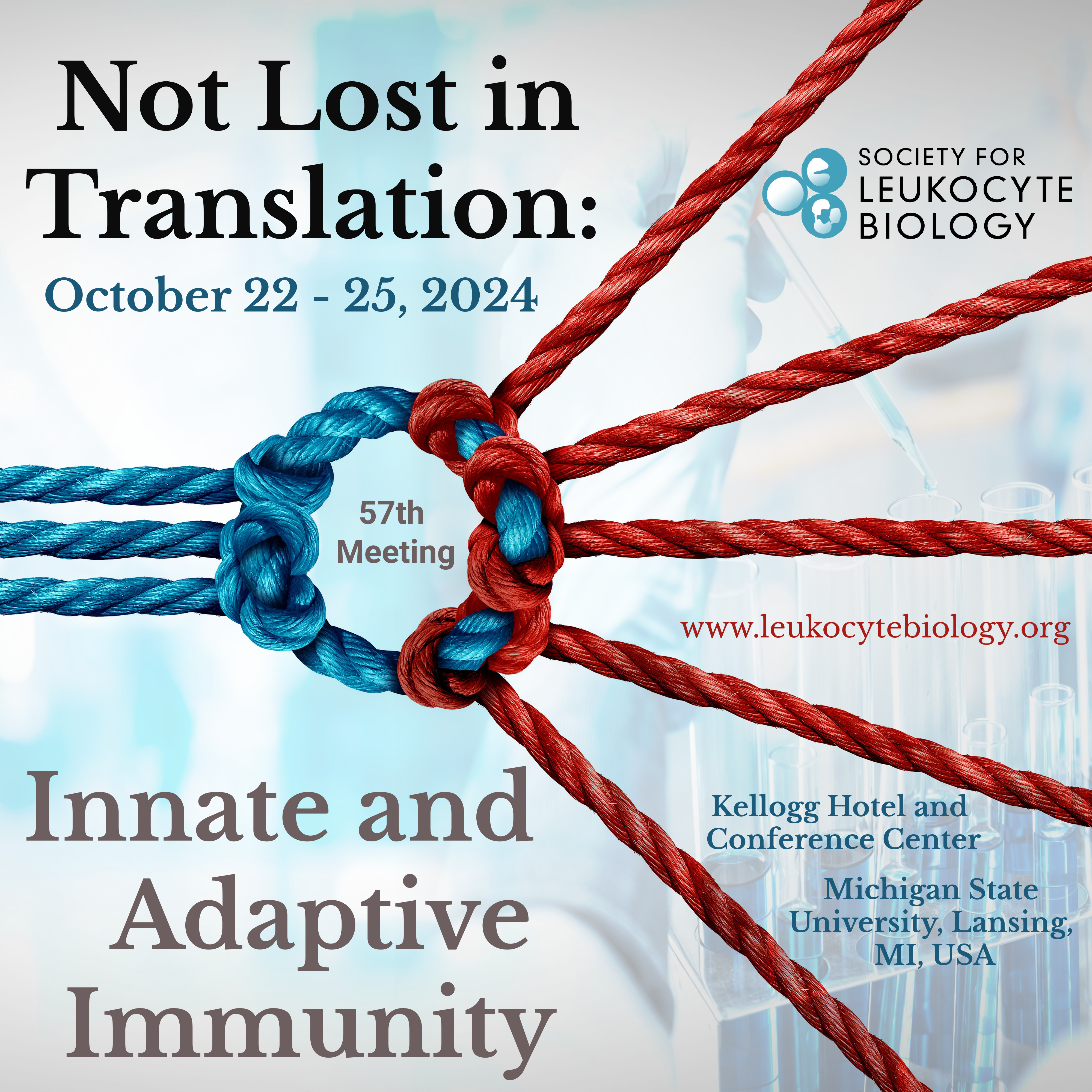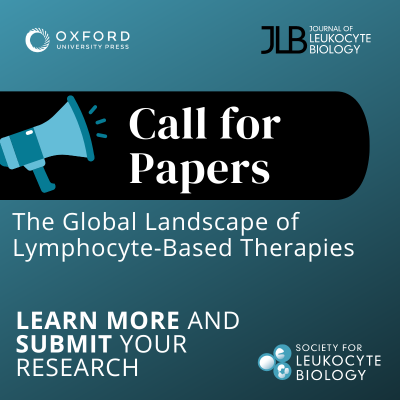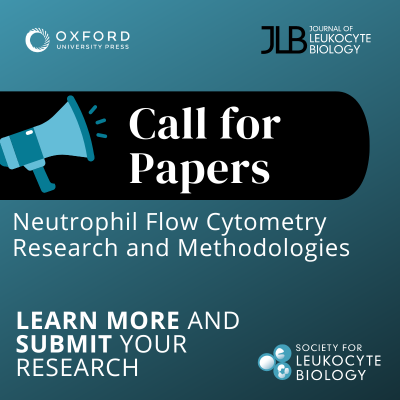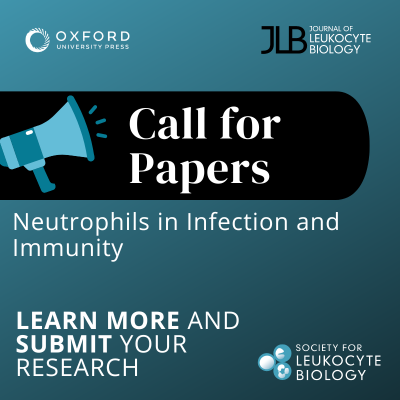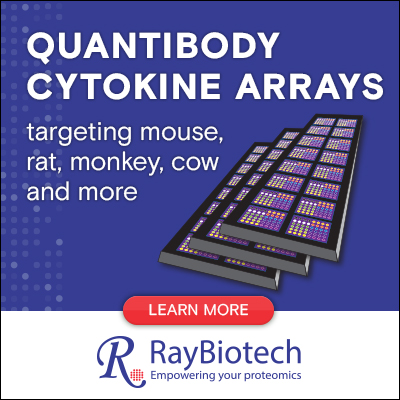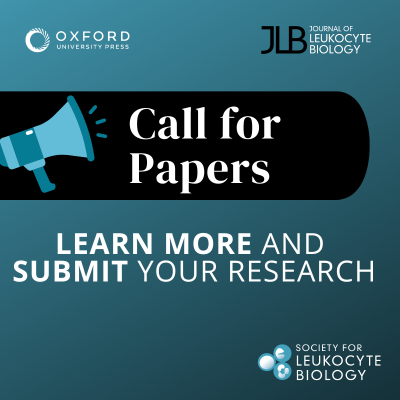| JLB Vol 112 Issue 6 TOC |
ISSUE INFORMATION Issue InformationPages: 1357-1363 | First Published: 25 November 2022 LETTERS TO EDITOR Circulating IL‐6 but not neutrophil extracellular traps levels can predict anakinra effectiveness in patients with severe COVID‐19 Vanessa Granger, Audrey Fels, Thomas Huet, Jean-Louis Laplanche, Sophie Laplanche, Gilles Chatellier, Hélène Beaussier, Sylvie Chollet-Martin, Luc de Chaisemartin, Gilles Hayem
Pages: 1365-1367 | First Published: 15 June 2022 EDITORIAL COMMENTARY Aging and macrophages: Not standing the test of time? Suhas Sureshchandra, Ilhem Messaoudi
Pages: 1369-1370 | First Published: 29 June 2022 SPOTLIGHT ON LEADING EDGE RESEARCH Advanced age is associated with changes in alveolar macrophages and their responses to the stress of traumatic injury Devin M. Boe, Holly J. Hulsebus, Kevin M. Najarro, Juliet E. Mullen, Hyunmin Kim, Aik Choon Tan, Rachel H. McMahan, Elizabeth J. Kovacs
Pages: 1371-1386 | First Published: 19 September 2022 Cell Development, Differentiation and Trafficking Selenoprotein I deficiency in T cells promotes differentiation into tolerant phenotypes while decreasing Th17 pathology Chi Ma, FuKun W. Hoffmann, Lance G. Nunes, Frank Urena, Anastasia Andrukhiv, Mariana Gerschenson, Matthew W. Pitts, Peter R. Hoffmann
Pages: 1387-1397 | First Published: 02 August 2022 Inflammation, Extracellular Mediators, and Effector Molecules The extracellular sialidase NEU3 primes neutrophils Sara A. Kirolos, Darrell Pilling, Richard H. Gomer
Pages: 1399-1411 | First Published: 28 July 2022 Dectin‐1 signaling in neutrophils up‐regulates PD‐L1 and triggers ROS‐mediated suppression of CD4+ T cells M. Elizabeth Deerhake, Emre D. Cardakli, Mari L. Shinohara
Pages: 1413-1425 | First Published: 08 September 2022 Epigallocatechin‐3‐gallate reduces neutrophil extracellular trap formation and tissue injury in severe acute pancreatitis Hongxuan Li, Cong Qiao, Lingyu Zhao, Qingxu Jing, Dongbo Xue, Yingmei Zhang
Pages: 1427-1443 | First Published: 19 August 2022 ILC3‐like ILC2 subset increases in minimal persistent inflammation after acute type II inflammation of allergic rhinitis and inhibited by Biminkang: Plasticity of ILC2 in minimal persistent inflammation Xiang-Jing Chen, Cheng Liu, Shan Zhang, Li-Feng Zhang, Wei Meng, Xin Zhang, Meng Sun, Yue Zhang, Ren-Zhong Wang, Cheng-Fang Yao
Pages: 1445-1455 | First Published: 26 September 2022 Host Defense and Pathophysiology Campylobacter jejuni induces differentiation of human neutrophils to the CD16hi/CD62Llo subtype Carolina G. Dolislager, Sean M. Callahan, Dallas R. Donohoe, Jeremiah G. Johnson
Pages: 1457-1470 | First Published: 22 July 2022 IL‐22 and Lactobacillus delbrueckii mitigate alcohol‐induced exacerbation of DSS‐induced colitis Abigail R. Cannon, Esther H. Shim, Paulius V. Kuprys, Mashkoor A. Choudhry
Pages: 1471-1484 | First Published: 02 August 2022 Neutrophil functional heterogeneity is a fixed phenotype and is associated with distinct gene expression profiles Stacey A. Maskarinec, Margaret McKelvy, Kimberly Boyle, Halie Hotchkiss, Madelaine E. Duarte, Bechtler Addison, Nicholas Amato, Sanjay Khandelwal, Gowthami M. Arepally, Grace M. Lee
Pages: 1485-1495 | First Published: 02 August 2022 TRANSLATIONAL AND CLINICAL IMMUNOLOGY In vitro‐induced Foxp3+CD8+ regulatory T cells suppress allergic IgE response in the gut Shilpi Giri, Heikrujam Thoihen Meitei, Sandip Ashok Sonar, Saumitra Shaligram, Girdhari Lal
Pages: 1497-1507 | First Published: 24 August 2022 Meeting: Targeted Science Issue - 2021 SLB Virtual Annual Meeting Guest Editors: Vidula Vachharajani, Laura Nagy REVIEWS Sepsis, pyruvate, and mitochondria energy supply chain shortage Charles E. McCall, Xuewei Zhu, Manal Zabalawi, David Long, Matthew A. Quinn, Barbara K. Yoza, Peter W. Stacpoole, Vidula Vachharajani
Pages: 1509-1514 | First Published: 22 July 2022 Metabolic impact of adipose tissue macrophages in the early postnatal life Tamás Röszer
Pages: 1515-1524 | First Published: 28 July 2022 Immunopathology of chronic critical illness in sepsis survivors: Role of abnormal myelopoiesis Jaimar C. Rincon, Philip A. Efron, Lyle L. Moldawer
Pages: 1525-1534 | First Published: 04 October 2022 A novel strategy to dissect multifaceted macrophage function in human diseases Keaton Karlinsey, Lili Qu, Alyssa J. Matz, Beiyan Zhou
Pages: 1535-1542 | First Published: 21 June 2022 PRIMARY RESEARCH Contact‐dependent, polarized acidification response during neutrophil–epithelial interactions Ian M. Cartwright, Alexander S. Dowdell, Camila Hanson, Rachael E. Kostelecky, Nichole Welch, Calen A. Steiner, Sean P. Colgan
Pages: 1543-1553 | First Published: 08 June 2022 Divergent Golgi trafficking limits B cell‐mediated IgG sialylation Leandre M. Glendenning, Julie Y. Zhou, Kalob M. Reynero, Brian A. Cobb
Pages: 1555-1566 | First Published: 21 June 2022 Meeting: Targeted Science Issue - 6th International Conference on Cancer Precision Medicine 2021 Guest Editors: Xiubao Ren, Jingting Jiang, Xiao Zheng, Quanli Gao, Jiuwei Cui, Yunbin Ye, and Feng Wei PRIMARY RESEARCH Dysregulated Th1 cells in lung squamous cell carcinoma Jiahui Wang, Jian Zhou, Qiuru Zhou, Ying Qi, Peng Zhang, Cihui Yan, Xiubao Ren
Pages: 1567-1576 | First Published: 10 June 2022 Altered MUC1 epitope‐specific CTLs: A potential target for immunotherapy of pancreatic cancer Jingwen Hong, Guoxiang Guo, Suxin Wu, Shengzhe Lin, Zhifeng Zhou, Shuping Chen, Chunmei Ye, Jieyu Li, Wansong Lin, Yunbin Ye
Pages: 1577-1590 | First Published: 12 October 2022 Relationship and prognostic significance of IL‐33, PD‐1/PD‐L1, and tertiary lymphoid structures in cervical cancer Ying Zhang, Jing Li, Fan Yang, Xiying Zhang, Xiubao Ren, Feng Wei
Pages: 1591-1603 | First Published: 02 May 2022 The prognostic value of a 4‐factor neoimmunologic score system in non‐small cell lung cancer Fan Yang, Ziqing Zeng, Yuan Li, Dong Zhang, Feng Wei, Hua Zhao, Peng Zhang, Xiubao Ren
Pages: 1605-1619 | First Published: 08 September 2022 Dynamic immune ecosystem of dengue infection revealed by single‐cell sequencing Gang Xu, Yueying Gao, Tao Pan, Si Li, Ya Zhang, Jing Guo, Zhanyu Tian, Juan Xu, Yongsheng Li, Xia Li
Pages: 1621-1631 | First Published: 29 June 2022 Single‐cell phenotypic profiling to identify a set of immune cell protein biomarkers for relapsed and refractory diffuse large B cell lymphoma: A single‐center study Yuan Shi, Weidong Ding, Weiying Gu, Yangling Shen, Haiqian Li, Zhuojun Zheng, Xiao Zheng, Yan Liu, Yun Ling
Pages: 1633-1648 | First Published: 30 August 2022 Meeting: Targeted Science Issue - The 9th International Gamma Delta T Cell Conference for 2021 Guest Editors: Zhinan Yin, Wenwei Tu, Jian Huang, Jianlei Hao, and Zheng Xiang REVIEWS The role of γδ T17 cells in cardiovascular disease Shaoxue Ling, Zonghao You, Yang Li, Jian Zhang, Shuwu Zhao, Yongzhi He, Xi Chen
Pages: 1649-1661 | First Published: 08 September 2022 γδ T cells: The potential role in liver disease and implications for cancer immunotherapy He Ren, WanJing Li, Xin Liu, Na Zhao
Pages: 1663-1668 | First Published: 13 September 2022 γδ T cell exhaustion: Opportunities for intervention Di Chen, Yinglu Guo, Jiahuan Jiang, Pin Wu, Ting Zhang, Qichun Wei, Jian Huang, Dang Wu
Pages: 1669-1676 | First Published: 24 August 2022 PRIMARY RESEARCH IL‐1β/NF‐κB signaling inhibits IGF‐1 production via let‐7f‐5p in dendritic epidermal T cells Yashu Li, Juan Wang, Yangping Wang, Weifeng He, Yixin Zhang, Yan Liu
Pages: 1677-1690 | First Published: 19 September 2022 TIGIT‐expressing zoledronate‐specific γδ T cells display enhanced antitumor activity Hongqin You, Huifang Zhu, Yajie Zhao, Jindong Guo, Quanli Gao
Pages: 1691-1700 | First Published: 10 November 2022 Reviving human γδT cells from apoptosis induced by IL‐12/18 via p‐JNK inhibition Yuan Song, Huey Yee Teo, Yonghao Liu, Xiaomeng Zhang, Jinmiao Chen, Yongliang Zhang, Haiyan Liu
Pages: 1701-1716 | First Published: 30 June 2022 |
































